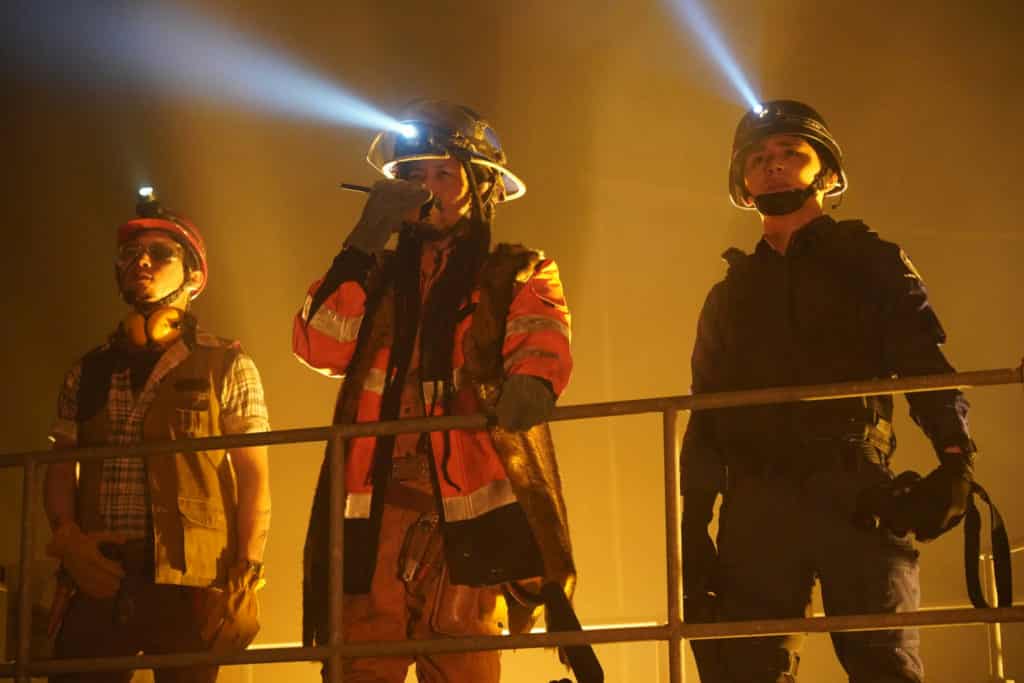
Remember that meme from a few years ago which pointed out that if you run Godzilla backwards, it’s the story of a benevolent lizard who builds a city before moonwalking into the sea? Yeah, yeah, but it raises a valid point: you have to wonder, in those many fine films where a city gets decimated by a kaiju, what the hell happens next. Well, wonder no more: director Satoshi Miki takes this scenario for his starting point in What To Do With The Dead Kaiju? (2022) – but there’s far more to this than just a bizarre logistical problem.
As a voiceover explains, Japan had been under attack by a kaiju but – after being struck with some sort of mysterious light – it’s upped and died, and is now an ex-kaiju, lying prostrate out on the outskirts of Tokyo. This has left Japan with an issue, or several: people had responded to this cause, conscriptions into the army were underway and society was working well as a whole, united against a common foe. The foe has been taken away: now what? The army hasn’t instantly been stood down, because you never know what’s coming next; the kaiju is no longer a threat per se, but people are still being advised to stay indoors, so the streets are still deserted. It’s a source of frustration for many Japanese people, who are keen to get back to normal, rejecting what has been termed the ‘kaiju-normal’.
And then there’s the governmental nightmare of how to handle this new situation. You can’t just leave a colossal creature to decompose into Japan’s waterways, but no one wants the job of disposing of it: a recce of the death site by helicopter reaffirms just what an impossible job this is going to be, one which is ideal to… nominate someone else to do. Various ideas and solutions get mooted, all of which get chewed over by a cabal of government ministers – and the JSF, the Japan Special Force, a special military division which suddenly finds itself without a clear function. Alongside all of this, we have a Gojira-worthy love triangle in the form of the Prime Minister’s aide Amane (Gaku Hamada); his wife Yukino (Tao Tsuchiya), secretary to the environmental minister and former lover of – JSF wunderkind, Arata (Ryôsuke Yamada).
This film could have been developed in a number of different ways: what it turns out to be, perhaps surprisingly, is a gentle, but pointed social satire. It mocks Japan and especially Japanese governance, but also Japan’s relationship to the rest of the world, with a few neat nods to our global post-pandemic situation, particularly in the public’s perceived reliance on government to promote the ‘right’ narrative. The government definitely sees it as part of its remit to manipulate people, albeit with good intent (giving the dead kaiju a name, ‘Hope’, both to ensure ownership over it in a globalist world and to promote it as a potential Japanese tourist destination, is particularly funny).
The film also teases the US-driven military model, playing with some of the same iconography and imagery familiar from the end of WWII; in a similar vein, the JSF resemble a kind of kaiju Top Gun in some ways, always at odds with the establishment, but begrudgingly needed, even admired. Most of all, though, the film makes fun of bureaucracy – its self-importance, self-promotion and buck-passing. The government is chaotically self-serving and whilst some phrases may be lost in translation (even if some of the Japanese characters seem pretty baffled by some of the same aphorisms) the cumulative effect is the same: the film is primarily a humorous, self-effacing farce. The situation is extraordinary, but the responses are human, all too human; it doesn’t scrimp on physical humour either.
The kaiju itself may be stone dead, but it’s still quite a presence: there are still some cool creature FX, with decent CGI and a sense of the scale of the creature, which works well overall. So a sense of scale, a sense of threat, and the ick factor: these are all in there. At just shy of two hours that’s an overabundance of scale, threat and ick perhaps (the film’s excessive length is its biggest issue) – but on the whole, What To Do With The Dead Kaiju? offers an entertaining perspective on an aspect – and a burning question – of Japanese genre cinema.
What To Do With The Dead Kaiju? (2022) appeared at the Fantasia International Film Festival.
